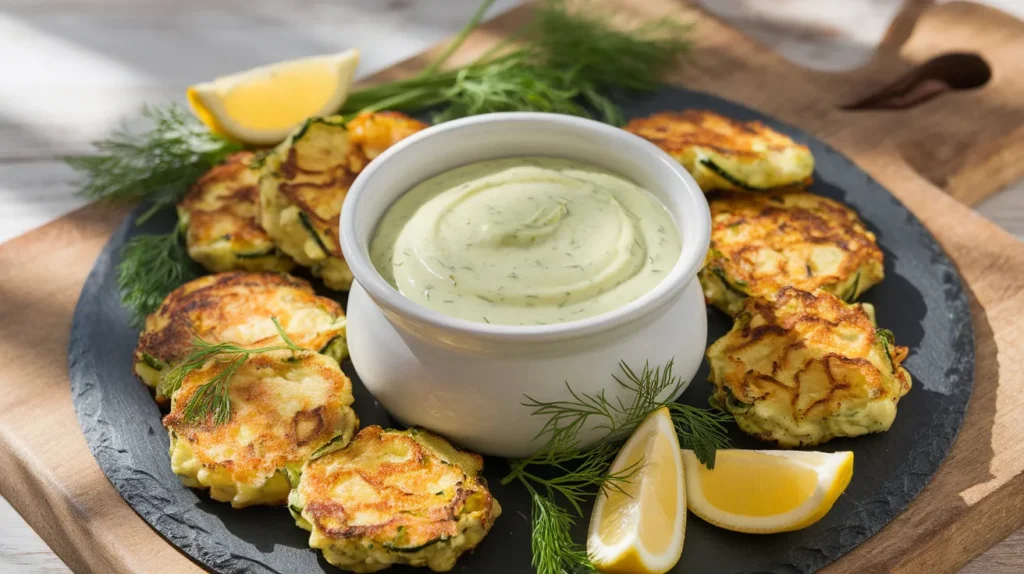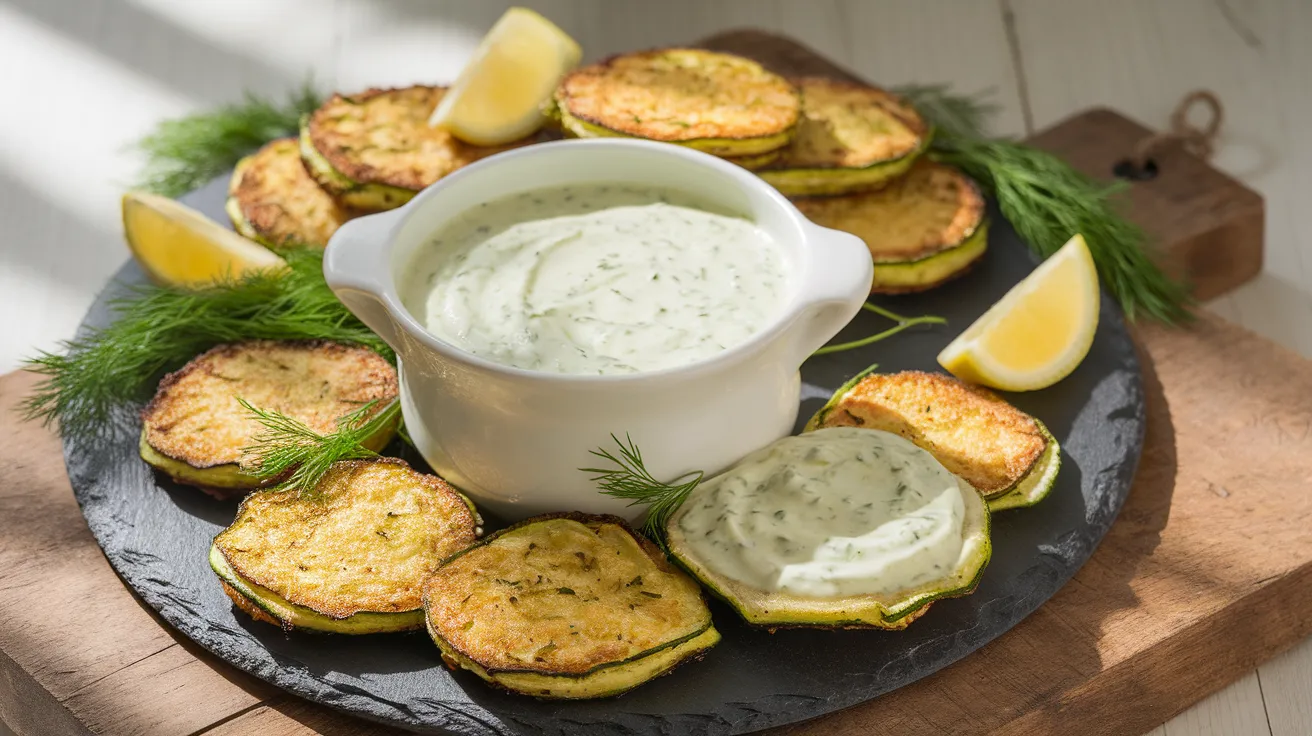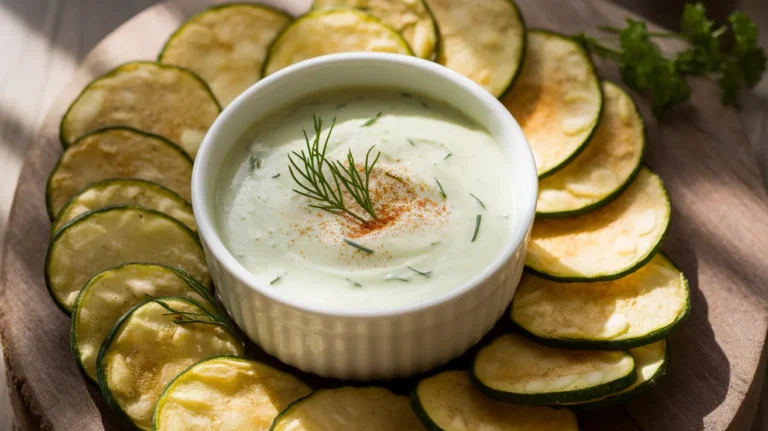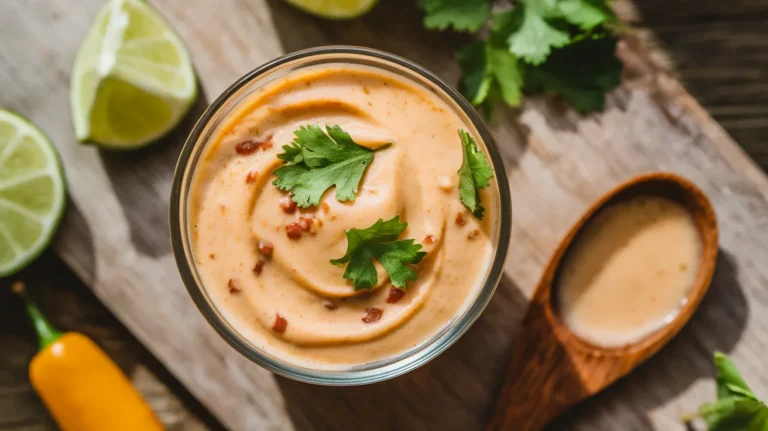This restaurant-quality sauce for zucchini fritters combines tangy Greek yogurt with fresh herbs and bright lemon flavors to create the perfect complement to crispy vegetable fritters. Our foolproof sauce for zucchini fritters recipe delivers creamy, flavorful results every time, transforming simple fritters into an elegant appetizer that guests will rave about.
SERVES: 4 | PREP: 15 MIN | COOK: 5 MIN | TOTAL: 20 MIN
Ingredients
For the Base Sauce
| Ingredient | Amount | Notes |
|---|---|---|
| Greek yogurt (plain) | 1 cup | Full-fat preferred |
| Mayonnaise | 3 tablespoons | Real mayo, not miracle whip |
| Fresh lemon juice | 2 tablespoons | About 1 large lemon |
| Lemon zest | 1 teaspoon | Finely grated |
For the Flavor Profile
| Ingredient | Amount | Notes |
|---|---|---|
| Fresh dill | 2 tablespoons | Finely chopped |
| Fresh chives | 1 tablespoon | Chopped fine |
| Garlic cloves | 2 medium | Minced or pressed |
| Dijon mustard | 1 teaspoon | Smooth variety |
| Salt | 1/2 teaspoon | Kosher or sea salt |
| Black pepper | 1/4 teaspoon | Freshly ground |
| Smoked paprika | 1/4 teaspoon | Optional but recommended |
Detailed Step-by-Step Instructions for Beginners
Phase 1: Preparation and Setup (8-10 minutes)
- Remove your Greek yogurt from the refrigerator and place it on the counter for 10-15 minutes before you begin. Cold yogurt is thick and difficult to mix smoothly. Room temperature yogurt will blend effortlessly with other ingredients and create a silky texture. You’ll know it’s ready when you can easily stir it with a spoon without resistance.
- Wash your fresh herbs thoroughly under cold running water, paying special attention to removing any grit or dirt from the stems. Gently shake off excess water, then lay the herbs on clean paper towels. Pat them completely dry – this is crucial because any remaining water will thin your sauce and make it watery. Wet herbs also don’t chop cleanly and can turn mushy.
- Prepare your lemon properly by first washing it under warm water and drying it completely. Using a microplane grater or the finest side of a box grater, carefully zest only the bright yellow outer peel, avoiding the bitter white pith underneath. Work in one direction and rotate the lemon frequently. After zesting, roll the lemon firmly on the counter while pressing down – this breaks internal membranes and makes juicing easier.
- Set up your workspace with all ingredients within arm’s reach. This French cooking technique called “mise en place” prevents mistakes and makes cooking smoother. Use small bowls to hold your measured ingredients, and have your mixing bowl, whisk, and measuring tools ready.
Phase 2: Creating the Creamy Base (5-7 minutes)
- Measure your Greek yogurt using a dry measuring cup, leveling it off with a knife for accuracy. Place it in your medium mixing bowl. The yogurt should be thick but not cold and stiff. If it seems too thick, let it sit at room temperature for a few more minutes.
- Add the mayonnaise to the yogurt and immediately begin whisking. Start with gentle circular motions to combine, then switch to more vigorous whisking. Whisk for a full 30-60 seconds until the mixture is completely smooth and uniform in color. There should be no streaks of white yogurt or mayo visible. If you see lumps, keep whisking – they will eventually disappear.
- Slowly drizzle in the fresh lemon juice while continuously whisking. Don’t dump it all in at once, as this can cause the mixture to separate or become grainy. Add it in a thin stream over 15-20 seconds while whisking constantly. The mixture should remain smooth and creamy. If it looks slightly separated, whisk more vigorously for another 30 seconds.
Phase 3: Preparing the Aromatics (6-8 minutes)
- Prepare your garlic with care by first removing the papery outer skin from each clove. Place the flat side of your knife over the garlic and give it a firm press – this loosens the skin for easy removal. Chop the garlic very finely, making pieces no larger than 1/8 inch. Alternatively, use a garlic press, but scrape out every bit of pressed garlic from both sides of the press. Fresh garlic is essential – powdered garlic won’t provide the same bright flavor.
- Add the minced garlic and Dijon mustard to your yogurt mixture. The mustard adds not just flavor but also helps emulsify the sauce, keeping it smooth and stable. Whisk these ingredients in thoroughly, making sure the garlic is evenly distributed throughout the sauce. You shouldn’t see any clumps of garlic or streaks of mustard.
Phase 4: Incorporating Fresh Herbs (4-5 minutes)
- Chop your dill with precision by gathering the fronds (the feathery parts) together and using a sharp knife to cut them into very small pieces, about 1/8 inch or smaller. Rock your knife back and forth rather than pressing straight down, which can bruise the delicate herbs. Avoid chopping the thick stems, which can be bitter and tough.
- Prepare the chives by cutting them with scissors or a sharp knife into tiny rounds, almost like confetti. Chives are hollow, so cutting them cleanly prevents them from becoming mushy. If using a knife, make sure it’s very sharp and use a gentle rocking motion.
- Fold in the fresh herbs carefully using a rubber spatula or large spoon rather than whisking. Whisking can bruise the herbs and turn them dark. Use gentle folding motions, lifting the sauce from the bottom and folding it over the herbs. Continue until the herbs are evenly distributed throughout the creamy sauce for zucchini fritters.
Phase 5: Seasoning and Flavor Balance (3-4 minutes)
- Season thoughtfully with salt by starting with just 1/4 teaspoon, then tasting before adding more. Different brands of yogurt and mayo contain varying amounts of sodium, so you need to taste as you go. Salt doesn’t just add saltiness – it brightens all the other flavors and makes the lemon and herbs taste more vibrant.
- Add freshly ground black pepper for the best flavor. Pre-ground pepper loses its potency quickly and won’t provide the same aromatic punch. If you don’t have a pepper grinder, crush whole peppercorns with the flat side of a knife or use the small amounts from packets.
- Incorporate the smoked paprika if using – this optional ingredient adds a subtle smokiness and beautiful color that complements the crispy exterior of zucchini fritters. Stir it in completely to avoid streaks of red color.
Phase 6: Final Touches and Quality Check (2-3 minutes)
- Add the lemon zest last to preserve its bright, essential oils that dissipate quickly when mixed vigorously. Fold it in gently with just a few strokes. The zest should be visible as tiny yellow flecks throughout the sauce.
- Taste your sauce for zucchini fritters and adjust seasonings as needed. The sauce should taste bright and tangy from the lemon, creamy from the yogurt and mayo, herbaceous from the fresh herbs, and have a pleasant garlic presence without being overwhelming. If it tastes flat, add more salt. If it needs brightness, add more lemon juice drop by drop.
- Check the consistency – it should coat a spoon lightly but not be thick like frosting. If too thick, thin with water or additional lemon juice one teaspoon at a time. If too thin, refrigerate for 15 minutes to allow natural thickening.
Phase 7: Resting and Final Preparation (15-20 minutes)
- Cover the sauce with plastic wrap, pressing it directly onto the surface to prevent a skin from forming. This also prevents the sauce from absorbing refrigerator odors.
- Refrigerate for at least 15-20 minutes before serving. This resting period allows the garlic to mellow, the herbs to infuse their flavors throughout, and the sauce to reach its optimal consistency. The flavors will continue developing for up to 4 hours.
- Give the sauce a final gentle stir before serving, as some separation is natural after chilling. Taste once more and adjust seasonings if needed – cold foods often need slightly more seasoning than warm ones.
Chef’s Notes
• Consistency Control: If your sauce for zucchini fritters becomes too thick after chilling, thin it with cold water one teaspoon at a time rather than more lemon juice, which can make it too acidic.
• Make-Ahead Magic: This sauce actually improves after 2-4 hours of resting, making it perfect for entertaining when you want to prep components ahead of time.
• Herb Substitutions: Fresh herbs are crucial for the best flavor, but if you must substitute dried herbs, use only 1/3 the amount and add them 30 minutes before serving.
• Garlic Intensity: For a milder garlic flavor, rub the mixing bowl with a cut garlic clove instead of adding minced garlic directly to the sauce.
Nutrition Information (Per Serving)
- Calories: 95
- Protein: 4g
- Carbohydrates: 3g
- Fat: 8g
- Fiber: 0g
- Sodium: 285mg
Creative Sauce for Zucchini Fritters Variations
Mediterranean Twist
Add 1 tablespoon of chopped fresh mint and 1 teaspoon of dried oregano for a Greek-inspired version that pairs beautifully with Mediterranean-style fritters.
Spicy Kick Version
Incorporate 1-2 finely minced jalapeño peppers and a pinch of cayenne pepper for those who enjoy heat with their vegetables.
Herb Garden Delight
Mix in fresh basil and parsley alongside the dill for a more complex herbal profile that complements summer garden vegetables perfectly.
Creamy Avocado Style
Blend in half of a ripe avocado for an ultra-creamy texture and subtle richness that makes this sauce perfect for sauce for zucchini chips as well.
Storage & Reheating Guidelines
Refrigerator Storage: Keep covered in the refrigerator for up to 5 days. The flavors actually develop and improve during the first 24 hours.
Freezing: This sauce doesn’t freeze well due to the dairy content, which will separate upon thawing.
Serving Temperature: Serve chilled or at room temperature. Let it sit out for 10 minutes before serving if it’s been refrigerated for optimal consistency.
Consistency Recovery: If separation occurs, whisk vigorously or use an immersion blender for 10-15 seconds to re-emulsify.

Troubleshooting Your Sauce for Zucchini Fritters
Problem: Sauce is too thin
Solution: Add more Greek yogurt, one tablespoon at a time, or refrigerate for an additional 30 minutes to allow natural thickening.
Problem: Too garlicky or harsh
Solution: Balance with additional Greek yogurt and a pinch of sugar, or let it rest longer as garlic mellows over time.
Problem: Lacks flavor depth
Solution: Add more salt (the most common culprit), extra lemon juice, or a dash of white wine vinegar for brightness.
Problem: Sauce separated or looks curdled
Solution: This happens when ingredients are too cold. Let everything reach room temperature and whisk vigorously to re-combine.
Problem: Herbs turned brown or wilted-looking
Solution: Always add fresh herbs last and fold gently. Brown herbs indicate over-mixing or herbs that weren’t completely dry.
Essential Equipment
- Medium mixing bowl (glass or stainless steel preferred)
- Wire whisk for smooth blending
- Microplane or fine grater for lemon zest
- Sharp knife for herb chopping
- Cutting board (separate from raw meat prep)
- Measuring cups and spoons
- Garlic press (optional but helpful)
Shopping List by Store Section
Dairy Section
- Greek yogurt (plain, full-fat)
- Mayonnaise
Produce Section
- Fresh lemons (2-3 lemons needed)
- Fresh dill
- Fresh chives
- Garlic bulb
Condiment/Spice Aisle
- Dijon mustard
- Kosher salt
- Black peppercorns
- Smoked paprika
Success Secrets for Perfect Sauce for Zucchini Fritters
- Temperature Matters: Room temperature ingredients blend more easily and create a smoother final texture than cold ingredients straight from the fridge.
- Fresh Herb Technique: Chop herbs with a sharp knife using a rocking motion rather than pressing down, which bruises the delicate leaves and releases bitter compounds.
- Lemon Zest Timing: Add zest last to preserve the bright citrus oils that dissipate quickly when mixed vigorously or exposed to other acids.
- Taste as You Go: Build flavors gradually and taste after each addition. Your palate is the best guide for achieving perfect balance.
- Resting Period: Never skip the resting time – this sauce for zucchini fritters truly shines after the flavors have had time to marry and develop complexity.
This versatile sauce works wonderfully as a base for sauce for zucchini noodles with slight modifications, making it a valuable recipe to master for multiple zucchini preparations throughout the season.




